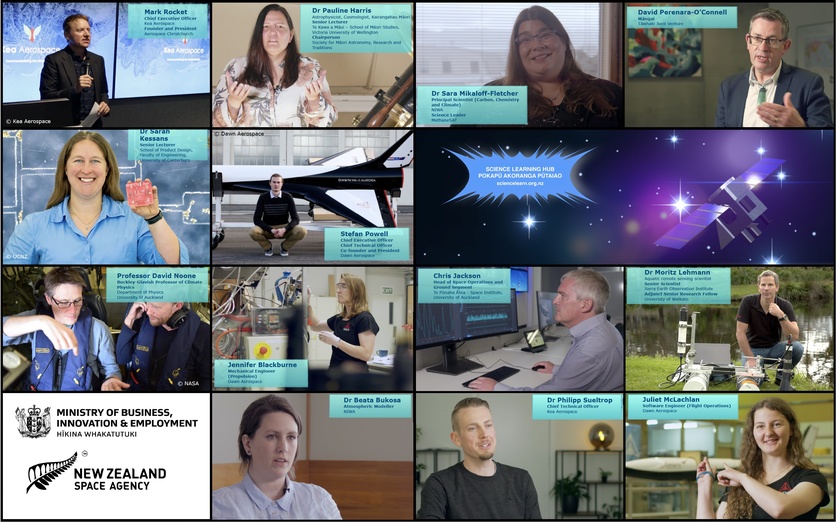Ever wondered who works in Aotearoa New Zealand’s space sector? It turns out more than 12,000 people do – and you can meet a few of them on the Hub.
Digital media features strongly in our resources. We are always keen to profile the engaging and passionate people who are on the cutting edge of their fields. The mahi we’ve developed in collaboration with the Ministry for Business, Innovation and Employment and the New Zealand Space Agency has enabled us to meet a raft of experts working in quite diverse fields – and catch up with a Kiwi space pioneer we first filmed in 2010!
The filming process
Rachel Douglas is the Hub’s media director, and she’s been the unseen force behind the videos we’ve been producing since 2005. Once the team and any stakeholders decide on the science ideas and concepts that we’d like to cover, Rachel is key to collaborating with the experts who can bring the topics to life.
Aotearoa in space encompasses three broad areas: te ao Māori connections with space, MethaneSAT – Aotearoa New Zealand’s first government-funded space mission – and the innovative people who are pushing the boundaries of aerospace industries and how we use them.
After extensive research, Rachel created a shortlist of kairangahau Māori, scientists and engineers who were able to squeeze us into their busy schedules – and then had to revise everything as COVID-19 restrictions hit the country. We were so disappointed when the disruptions meant we could no longer work with some of the experts that we’d planned to feature. The few concise days of filming ballooned into multiple trips to Wellington, Christchurch and eventually Auckland. After dates and flights were confirmed, accessing filming venues and booking busy camera technicians at short notice were the next hurdles.
On the positive side, Rachel’s persistence paid off. The film team were able to take a peek at some of the amazing feats of engineering at these venues but had to take care that intellectual property knowledge and trade secrets were kept safe! We feel hugely privileged to be in these locations and to speak with such talented people!
The real work begins
Once filming at the location is finished, the interviews are transcribed. The 13 interviews created hours of video that in turn created around 150 pages of written text. Rachel’s next job is to find the golden moments in all this goodness to feature in our short videos. We choose our interviewees because they are excellent communicators, so imagine how hard it is to weed out great material and put it aside! Rachel also finds ways to interweave people into compilation clips – balancing voices and ideas to create richer stories.
This is when video editor Tom Goulter gets involved. Tom takes all of the puzzle pieces that Rachel creates and puts them together to create smoothly flowing narratives. Tom is also a very dab hand at creating cool video animations to explain some of the more abstract concepts our experts make reference to – including dancing molecules!
Tom uses images and additional film (known as B-roll) to further illustrate the concepts and add interest. This project had a few speed bumps. Due to COVID-19 and IP restrictions, we weren’t able to film as much B-roll as we usually do. We’ve been fortunate that individuals and organisations have allowed us to use their footage and images to educate tamariki. We’d like to specifically mention the generosity of Dr Ian Griffin – an outstanding astro-photographer and videographer. Ian is also the director of Otago Museum, which is developing the Tūhura Tuarangi – Aotearoa in Space Showcase, that our resources will support.
And the work continues!
We want to present the experts in the best light possible and to ensure that we stay true to their kōrero and the science and mātauranga, so we provide them with the clips for feedback. There’s often a few more passes in the editing suite and continued consultation with the writers. We’ve yet to really ascertain how much time goes in to a 2-minute video, but we don’t put anything on the website until it’s gone through several layers of quality control.
It’s worth all of the effort – research shows the Hub’s videos enable students to see themselves in science and gain a deeper understanding of the topic and how science works.
A shout out to our space experts
The people we feature in our Hub videos volunteer their time. Their enthusiasm and passion for their research and the clarity of thought they provide are very much appreciated by the Hub team and our audience!
Our thanks to our space experts: kairangahau Māori SMART chairperson Dr Pauline Harris and Tāwhaki Joint Venture māngai David Perenara-O’Connell; MethaneSAT scientists Dr Sara Mikaloff-Fletcher, Dr Beata Bukosa and Professor David Noone and engineer Chris Jackson; researchers Dr Sarah Kessans and Dr Moritz Lehmann; innovators Jennifer Blackburne, Juliet McLachlan and Stephan Powell from Dawn Aerospace; and Dr Philipp Sueltrop and space pioneer Mark Rocket from Kea Aerospace. A big shout out to all the comms and support people who helped to get the right people in the right place for filming and feedback.
We are excited to tell your stories and incredibly proud to present Aotearoa New Zealand’s fast-growing space sector to the world! This introductory article provides a taste of what is on offer.
Related content
Video isn’t the only way to connect with scientists! Find out how Napier students organised a virtual visit with Rocket Lab. We’ve taken some of the key points out of this article and put them into a framework.
Use the activity Communicating with scientists – interview techniques and etiquette if you plan to work with a science expert.
If you are a scientist or science expert who's been invited to a school and you are feeling a tad nervous about the experience, read the article School visits – hints for scientists. It contains some useful advice!
See all news



